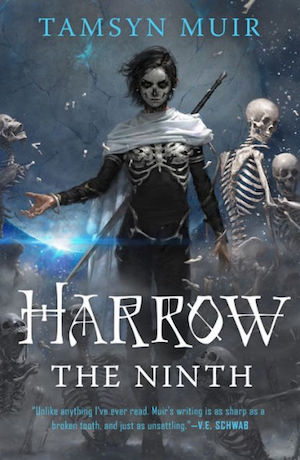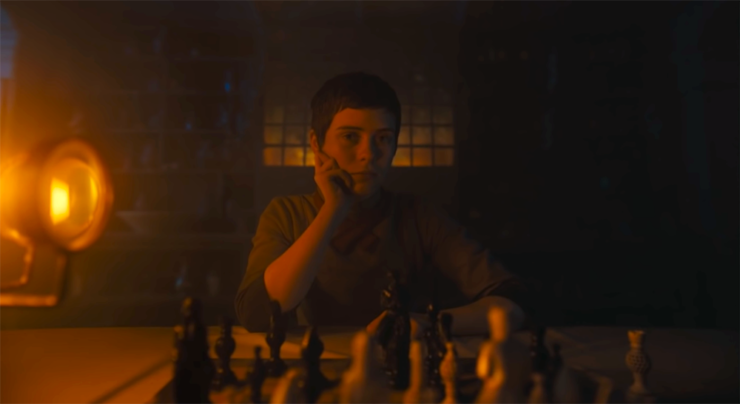In her book The Witches Are Coming, Lindy West sums up an entire four hundred years worth of history with the spot-fucking-on statement, “Americans are addicted to plausible deniability.” When I read that (in the midst of procrastinating from writing this article), it hit me: that’s what fairytales are. Fairytales provide answers to questions we don’t want to dwell on for too long. Fairytales have no nuance, no grey area, no maybes. I’m not just talking about the versions that Disney fed to us with a spoonful of sugar, either. Fairytales are, inclusively, drawn with clear borders and clear answers. There are the good guys and the bad guys, a battle between the two, and a neat resolution without fail…and within that resolution, a lesson, of course.
All this to say, I walked into Gretel & Hansel expecting to be entertained but underwhelmed.
I expected answers to questions. I knew the reductive lesson already (unmarried women are witches; don’t accept candy from strangers; if it’s too good to be true, it probably is; don’t eat and get fat even if you’re starving because fat people are gross). I figured the film version of this familiar story would slap a little Glossier Boy Brow on it, add a good Instagram filter, and make it fashion for Gen Z. I mean, wasn’t it already in the name? Gretel & Hansel. Get it? The girl’s name came first in the title! We’re flipping stereotypes on their heads! Girl power!
And I’m not saying that turning gendered and anachronistic tropes on their heads is bad… mostly. What it is is tired and problematic in the sense that it doesn’t so much question a broken system as it provides another answer to it, trying to retcon, like, one hundred years of bias in media. And all it accomplishes with this exercise is reinforce the same binary from whence it came. Of course, neither you nor I are here to blow up any binaries, and I didn’t think Gretel & Hansel was, either. I expected to walk out of the film feeling satisfied but not filled with anything meaningful, with some sort of milquetoast opinion I could write about.
Instead, I walked out of Gretel & Hansel and immediately googled the following: “chaos magick” and “third eye illuminati” and “immortality and cannibalism” and “triangle nature symbolism” and, finally, “menstruation witches lore.” The review could end there, but I have about three hundred more words to go and a lot more to say about menstruation, witches, and triangles.
Buy the Book


Harrow the Ninth
Gretel & Hansel begins with a meta retelling of Hansel and Gretel itself, featuring the stark profile of a woman in a pointed hat sitting atop a hill, surrounded by the outline of a triangle. It’s a shot that could have easily been at home in The Holy Mountain or The Void or Beyond the Black Rainbow. But, as successful as those films were in evoking a hallucinatory sort of dread with stylized, hyper-saturated, high contrast shots of Occult symbols, they also fell straight into their own masturbatory bullshit when it came to plot and anything close to character development.
In contrast, Gretel & Hansel manages to create compelling characters and plot alongside its mesmerizing cinematography and a soundscape that actually evolves with the characters. Gretel narrates the movie in the first person, so the audience experiences the other characters through her eyes. This colors younger brother Hansel in particular who, while innocent and scared, is also kind of an insufferable twat. After being cast out of their home by a distraught mother, the pair venture out to slowly starve to death in search of work, shelter, food. Gretel trudges on without complaint, while Hansel incessantly whines about what they don’t have, as if the whining will magically make it appear. He never accepts his circumstances. He wants to go home to his neglectful mother. He wants food. He wants, wants, wants, but is not only impotent in searching for these things, but also deluded in thinking they’ll just magically appear before him. Even after they find shelter with the suspiciously nice old lady with endless supplies of food to offer them, Hansel remains useless. While Gretel cleans the woman’s entire home to earn her keep, Hansel spends the day outside fucking around with an axe that’s too big for him, in a vain attempt to cut down a tree. Spoiler alert: he can’t.
Despite Gretel’s unique and personal narration, Gretel & Hansel unfolds the way we all know it does. But subversive plot twists and jarring imagery begin in earnest once the siblings settle into the home of the nice old lady (who is definitely not a cannibal). In one particular scene, Gretel peers in from outside and a tight shot of her eye in the peephole appears exactly like the ubiquitous third eye atop the pyramid of knowledge. Earlier, Gretel made an offhand comment about “seeing things others can’t,” which could have meant nothing. But the shot makes it clear: this girl is about to witness some spooky shit, and her role in the story is confirmed. She will be the one who knows what’s up before Hansel does and, just as she did in the forest, she’ll be the one who has to handle it.
Here the film begins to diverge from the fairytale most significantly, and the way it did gave me those waves of eager anticipation mixed with dread that true fans of horror want to live in. While Hansel is off trying to chop things with his big boy axe, the old witch takes Gretel under her tutelage to develop her power. She tries to convince Gretel that she’s transcended her old life, and that its trappings (her brother) are not serving her, but holding her back. As if proving this to the audience, we see Gretel walk outside in one scene and literally bend a fully-grown tree to her will, while Hansel is still trying to best a sapling. Then… flies. We hear the sounds of flies buzzing around piles of now-rotting food that only Gretel can see and I could’ve screamed over how subtle yet effective it was. Gretel’s about to call this baby-eating hag on her bullshit because there are files now and Gretel can see and hear them and it’s time for the student to become the teacher.
Gretel transforms from a young girl beholden to family responsibilities to a woman (quite literally; we see her get her first period during the film) harnessing a power that transcends her from a life with such little purpose. Almost as an act of camaraderie, the old cannibal crone reveals her true self to Gretel in a dream: she, too, is a young woman—an attractive one—wearing the mask of an elderly woman to disarm others. Suddenly, we have two vibrant, beautiful women who have shrunk themselves to fit into a world where women need to be small and sexless (whether young or old) to survive. One of them likes to eat children, and the other was raised to protect her younger brother (even if he is a drip).
During Gretel’s awakening, the movie shifts from a quaint folk horror tableau to something far more edgy and goth. Droning synth takes over the score and bold black and white color blocks mark the scenes. I am a huge fan of Guadagnino’s Suspiria and, as the film reached its climax, I almost expected a more ancient and powerful witch to crawl out of some hole and make everyone’s head explode. Then I remembered this movie was rated PG-13. All the same, the stark details and unsettling score in Gretel & Hansel’s latter half took something as anachronistic and juvenile as a fairytale and elevated it to a level of terror—even if it was just perceived terror—seen only in the most sophisticated horror films.
Without spoiling the movie’s end, Gretel ultimately becomes a woman with no home. Here, the film could have taken the fairytale way out by giving us answers, clear lines, and neon signs above characters’ heads that say “good” or “bad.” But it doesn’t. Wrapped up in the trappings of a fairytale, it gives us the antithesis of a fairytale ending. It leaves us with uncertainty, plenty of questions about how we view women and power, and more than a little discomfort (cannibalism aside). That discomfort is what’s radical, what’s more feminist than any all-female cast, because it doesn’t just hold a mirror up to gender politics… it smashes the whole goddamn thing.
Gretel & Hansel doesn’t retcon tired and problematic tropes. There was no “Look! A woman with agency!” routine. It was subtler, in spite of the somewhat heavy-handed title change. In fact, the film creators leveraged brilliantly the knowledge that its audience were so familiar with the story and its tropes so that it could sneak in its subversiveness unnoticed, until it couldn’t be denied.
Lauren Jackson (LJ) is the marketing/publicity manager at Saga Press and Gallery Books. Her primary areas of interest are true crime, horror, Star Trek, and making spreadsheets. Her sun is in Scorpio with a rising sign in Libra and a moon in Gemini, for which she is seeking professional help. You can find her on Twitter and Instagram @alsoknownaslj, or on Hinge if your filters are right.










